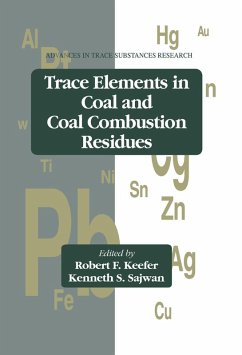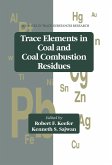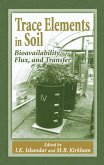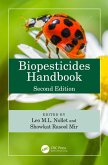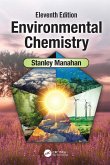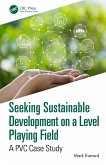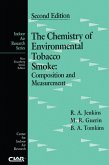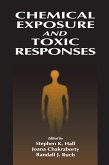303,95 €
303,95 €
inkl. MwSt.
Sofort per Download lieferbar

152 °P sammeln
303,95 €
Als Download kaufen

303,95 €
inkl. MwSt.
Sofort per Download lieferbar

152 °P sammeln
Jetzt verschenken
Alle Infos zum eBook verschenken
303,95 €
inkl. MwSt.
Sofort per Download lieferbar
Alle Infos zum eBook verschenken

152 °P sammeln
- Format: PDF
- Merkliste
- Auf die Merkliste
- Bewerten Bewerten
- Teilen
- Produkt teilen
- Produkterinnerung
- Produkterinnerung

Bitte loggen Sie sich zunächst in Ihr Kundenkonto ein oder registrieren Sie sich bei
bücher.de, um das eBook-Abo tolino select nutzen zu können.
Hier können Sie sich einloggen
Hier können Sie sich einloggen
Sie sind bereits eingeloggt. Klicken Sie auf 2. tolino select Abo, um fortzufahren.

Bitte loggen Sie sich zunächst in Ihr Kundenkonto ein oder registrieren Sie sich bei bücher.de, um das eBook-Abo tolino select nutzen zu können.
Trace Elements in Coal and Coal Combustion Residues focuses on trace metal chemistry of coal and coal combustion residues. Special emphasis is placed on management of coal combustion residues in electric power plants and the influence of coal and associated residues on soils, plants, water, and animals. Topics covered include a brief summary of res
- Geräte: PC
- mit Kopierschutz
- eBook Hilfe
Andere Kunden interessierten sich auch für
![Trace Elements in Coal and Coal Combustion Residues (eBook, ePUB) Trace Elements in Coal and Coal Combustion Residues (eBook, ePUB)]() Robert F. KeeferTrace Elements in Coal and Coal Combustion Residues (eBook, ePUB)303,95 €
Robert F. KeeferTrace Elements in Coal and Coal Combustion Residues (eBook, ePUB)303,95 €![Trace Elements in Soil (eBook, PDF) Trace Elements in Soil (eBook, PDF)]() Trace Elements in Soil (eBook, PDF)48,95 €
Trace Elements in Soil (eBook, PDF)48,95 €![Biopesticides Handbook (eBook, PDF) Biopesticides Handbook (eBook, PDF)]() Biopesticides Handbook (eBook, PDF)178,95 €
Biopesticides Handbook (eBook, PDF)178,95 €![Environmental Chemistry (eBook, PDF) Environmental Chemistry (eBook, PDF)]() Stanley E ManahanEnvironmental Chemistry (eBook, PDF)89,95 €
Stanley E ManahanEnvironmental Chemistry (eBook, PDF)89,95 €![Seeking Sustainable Development on a Level Playing Field (eBook, PDF) Seeking Sustainable Development on a Level Playing Field (eBook, PDF)]() Mark EverardSeeking Sustainable Development on a Level Playing Field (eBook, PDF)37,95 €
Mark EverardSeeking Sustainable Development on a Level Playing Field (eBook, PDF)37,95 €![The Chemistry of Environmental Tobacco Smoke (eBook, PDF) The Chemistry of Environmental Tobacco Smoke (eBook, PDF)]() Roger A. JenkinsThe Chemistry of Environmental Tobacco Smoke (eBook, PDF)188,95 €
Roger A. JenkinsThe Chemistry of Environmental Tobacco Smoke (eBook, PDF)188,95 €![Chemical Exposure and Toxic Responses (eBook, PDF) Chemical Exposure and Toxic Responses (eBook, PDF)]() Stephen K. HallChemical Exposure and Toxic Responses (eBook, PDF)62,95 €
Stephen K. HallChemical Exposure and Toxic Responses (eBook, PDF)62,95 €-
-
-
Trace Elements in Coal and Coal Combustion Residues focuses on trace metal chemistry of coal and coal combustion residues. Special emphasis is placed on management of coal combustion residues in electric power plants and the influence of coal and associated residues on soils, plants, water, and animals. Topics covered include a brief summary of res
Dieser Download kann aus rechtlichen Gründen nur mit Rechnungsadresse in A, B, BG, CY, CZ, D, DK, EW, E, FIN, F, GR, HR, H, IRL, I, LT, L, LR, M, NL, PL, P, R, S, SLO, SK ausgeliefert werden.
Produktdetails
- Produktdetails
- Verlag: Taylor & Francis eBooks
- Seitenzahl: 328
- Erscheinungstermin: 25. Oktober 2020
- Englisch
- ISBN-13: 9781000115130
- Artikelnr.: 60405306
- Verlag: Taylor & Francis eBooks
- Seitenzahl: 328
- Erscheinungstermin: 25. Oktober 2020
- Englisch
- ISBN-13: 9781000115130
- Artikelnr.: 60405306
- Herstellerkennzeichnung Die Herstellerinformationen sind derzeit nicht verfügbar.
Robert F. Keefer is a Professor in the Division of Plant and Soil Sciences, College of Agriculture and Forestry, at West Virginia University. Afterreceiving his B.S. in general agriculture from Cornell University and his M.S. and Ph.D. in soil science (agronomy) from Ohio State University, he worked two years as an organic chemist with Hercules Powder Company, and began his academic and research career in 1965 with West Virginia University. He has taught Soil Fertility, Soil Conservation and Management, Advanced Soil Fertility, the Chemistry of Soil Organic Matter, and part of a team-taught course on Plant Disorders. He devoted a year to teaching, conducting research, and developing a graduate program in soil science at Makerere University in Uganda and assisted one of his graduate students in Togo (West Africa). Dr. Keefer's research has been broad- beginning with soil fertility and soil test correlation, then branching into plant nutrition/soil chemistry relationship, especially dealing with micronutrients. Interest over the years shifted to use of agricultural manures, municipal wastes such as sewage sludge, and industrial byproducts such as coal ashes and sawdust, particularly with respect to environmental aspects of plant nutrition, toxicities, and heavy metal transport in soils, waters, plants, and animals. The geographical positioning of West Virginia in the center of the eastern U.S. coal field and the recent concern with maintaining or improving the quality of our environment led Dr. Keefer to develop a research program emphasizing constructive use of coal combustion by-products in reclaiming surface-mined land. His proficiency in this area is evidenced by the many calls he receives on this topic. Dr. Keefer's recent sabbatical was devoted mainly to producing a digest of research on the chemical composition and leaching characteristics of coal combustion by-products by the Electric Power Research Institute (EPRI) that will be published soon. He was a major contributor to a book section on arsenic mobilization and bioavailability in soils forthcoming in Advances in Environmental Science and Technology, entitled "Arsenic in the Environment." . Kenneth S. Sajwan is an Associate Professor of Biology and the Coordinator of Environmental Studies in the School of Sciences and Technology at Savannah State College. He received his Ph.D. in Soil Science (Agronomy) from Colorado State University. In addition, he holds a Ph.D. (Post Harvest Technology), M.S. (Agronomy), and B.S. (Agriculture & Animal Husbandry) from India. Prior to joining Savannah State College, Dr. Sajwan worked as an Assistant Research Ecologist in the Biogeochemical Ecology Division of the University of Georgia's Savannah River Ecology Laboratory. Earlier he worked as an ARS Scientist-Agronomy for the Indian Council of Agricultural Research; an Associate Professor-Water Use Management at the University of Roorkee, India; a World Bank Agricultural Consultant to Colombia, South America; and a Postdoctoral Fellow-Soil Chemistry at the University of Kentucky. Dr. Sajwan is also very active in teaching and has taught at the Indian Institute of Technology, University of Roorkee, Colorado State University, and the University of South Carolina. Dr. Sajwan's primary research interests include biogeochemistry of trace metals, soil-plant environmental chemistry, and groundwater quality and chemical equilibria in soils. Currently, Dr. Sajwan is investigating the potential benefits and environmental impact of applications of coal ash and organic waste mixtures to agricultural lands for crop production.
INTRODUCTION
Chapter 1: Coal Ashes
Industrial Wastes or Beneficial By
Products? R F Keefer
Abstract
Introduction
Results and Discussion
Bottom Ash and Boiler Slag Applications
Fly Ash Applications
Elements Found in Fly Ash, Soils, Plants, and Animals
Use of Fly Ash for Plant Growth
Disadvantages
Advantages
Enrichment Ratios
Emphasis in Present Work and Direction of Future Research References
Chapter 2: An Overview of Electric Power Institute (EPRI) Research Related to Effective Management of Coal Combustion
Residues
I.P Murarka, S.V Mattigod, and R.F Keefer
Abstract
Introduction
Characterization of Coal Combustion Solid Residues
Physical Properties
Chemical Properties
Composition of Extracts and Leachates
Laboratory Experiments
EPA Regulatory Tests Applied to Coal Combustion
Residues
Predictions of Leachate Compositions
Chemistry and Geochemistry of Residue Disposal
Laboratory Studies on Geochemical Parameters
Porewater and Leachate Composition from Field
Experiments
Fly Ash Test Cell
Disposal of FGD Wastes
Laboratory and Field Studies at Fly Ash Disposal
Sites
Development of Computer Models
Applications to Solid Residue Disposal Systems
Conclusions
Acknowledgments
References
ENVIRONMENTAL EFFECTS FROM POWER PLANTS
Chapter 3: Coal
Based Environmental Problems in a Low
Rainfall
Tropical Region
M. Agrawal, J. Singh, A. K. Jha, and J. S. Singh
Abstract
Introduction
Study Area
Location of Study Sites
Climate
Geology and Soil
Vegetation
Thermal Power Plants
Ambient Air Quality
Plant Performance in Relation to Air Quality
Fly Ash and Trace Elements
Coal Mine Spoil
Physicochemical and Biological Properties
General Floristics
Plant Community Development
Community Characteristics
Shoot Biomass
Root Biomass
Effect of Age and Microsites
Evaluation of Mine Spoil as a Medium for Plant Growth
Growth Performance of Certain Directly Seeded Plants
Conclusions and Recommendations
Acknowledgment
References
Chapter 4: Trace Element Concentrations in the Soft Tissue of Transplanted
Freshwater Mussels Near a Coal
Fired Power Plant
C. S. Klusek, M. Heit, and S. Hodgkiss
Abstract
Introduction
Experimental
Study Site
Sample Transplanting and Collection
Sample Preparation and Analysis
Mussels
Water and Sediment
Analytical Quality Control
Data Analysis
Results and Discussion
Element Concentrations in Mussels
Comparison of Metal Concentrations in Transplanted
Mussels and Lake George Mussels
Spatial and Temporal Variations in Mussel
Concentrations
Group 1 (Elevated)
Group 2
Relation of Mussel Tissue Concentrations to Concentrations in Water and Surface Sediments
Sediment and Water Concentrations
Sediment Enrichment Factors
Relation Between Mussel and Sediment
Concentrations
Relation Between Mussel and Water Concentrations Relation of Mussel Tissue Concentration to Coal
Combustion Products from Milliken Station
Trace Elements Released from Milliken Station
Relation of Metal Concentrations and Distance
from the Power Plant
Other Possible Sources of Pollution
Marinas
Agricultural Land Use
Conclusions
Acknowledgments
References
TESTS FOR AND MONITORING OF FOSSIL FUEL DISPERSION AND ASH DISPOSAL
Chapter 5: Strontium and Lead Isotopes as Monitors of Fossil Fuel
Dispersion
R. W. Hurst, T. E. Davis, A. A. Elseewi, and A. L. Page
Abstract
Introduction
The Geochemistry of Sr
Strontium in Mixtures
Isotopic Fractionation
Strontium Isotopes as Tracers of Fly Ash
Lead Isotopic Evolution in the Crust
Materials and Methods
Coal
Fired Power Plant
Coal Tar Site
Results and Discussion
Coal
Fired Power Plant
Criteria for Tracing FFR Dispersion
On
Site Soil Leachates
Off
Site Leachates and Brittlebush
Monitoring Well and Evaporation Pond Waters
Coal Tar Site
Lead Concentrations
Lead Isotopic Composition
Soil Samples
Water Samples
Strontium Concentration and Isotopic Results
Conclusions
Coal
Fired Power Plant
Coal Tar Site
References
Chapter 6: Baker Soil Test Applications for Land Reclamation,
Animal Health, and Food Chain Protection
D. E. Baker, F. G. Pannebaker, J. P. Senft and J. P. Coetzee
Abstract
Introduction
Theory and Evolution of the BST
Description of the BST
Applications of the BST
Sewage Sludge Treated Soils
Strip Mine Spoils
Fly Ash Disposal Areas
Soils Contaminated by Smelters
Coal Refuse Disposal Sites
Experiment No. 1
Experiment No. 2
Summary and Conclusions
Acknowledgments
References
TRANSPORT AND LEACHABILITY OF METALS FROM COAL AND ASH PILES
Chapter 7: Multicomponent Transport Through Soil Subjected to
Coal Pile Runoff Under Steady Saturated Flow
M. A. Anderson, P. M. Bertsch, and L. W. Zelazny
Abstract
Introduction
Materials and Methods
Study Site
Soils
Column Leaching Experiments
Analytical
Speciation
Results and Discussion
Coal Pile Runoff
Soils
Column Leaching Experiments
pH
Major Components
Alkali Metals
Alkaline Earth Metals
Transition Metals
Influence of Flow Rate on Observed Transport
Solubility Relations
Simple Modeling of Transport
Implications for Groundwater Systems
Summary and Conclusions
References
Chapter 8: Leachability of Ni, Cd, Cr, and As from Coal Ash Impoundments of Different Ages on the
Savannah River Site
S. S. Sandhu, G. L. Mills, and K. S. Sajwan
Abstract
Introduction
Materials and Methods
Study Area
Sampling Sites
Sample Collection
Leaching Studies
Sample Analysis
Results
Physical and Chemical Characteristics of the Ash
Effects of Solution pH
Leaching with Water
Leaching with Acid
Leaching with Base
Effect of Redox Conditions
Peroxide Leachate
Reducing Leachate
Discussion
Conclusions
Acknowledgments
References
USE OF COAL ASH FOR PLANT GROWTH
Chapter 9: Extractable and Plant Concentrations of Metals in Amended
Coal Ash
A. P. Schwab
Abstract
Introduction
Experimental
Site Preparation
Sampling and Analysis
Results and Discussion
Properties of the Ash
Vegetative Yield
Availability Indices and Plant Uptake
Nitrogen
Potassium
Phosphorus
Magnesium
Sodium
Boron
Copper and Mo
Zinc
Lead and Cd
Manganese
Barium, Ni, and Cr
Arsenic and Se
Summary and Conclusions
Acknowledgment
References
Chapter 10: Uptake of Chemical Elements by Terrestrial Plants
Growing on a Coal Fly Ash Landfill
L. H. Weinstein, M. A. Arthur, R. E. Schneider, P. B. Woodbury J. A. Laurence, A. O. Beers, and G. Rubin
Abstract
Introduction
Materials and Methods
Results
Soils
Forage Crops
First Cutting (Alfalfa, Clover, Timothy)
Second Cutting (Alfalfa, Clover)
Third Cutting (Alfalfa)
Root Crops
Early Summer Harvest
Late Summer Harvest
Gypsum Experiment
Gypsum Effects
Sweet Com and Field Com
Sweet Com
Field Com
Indigenous Species
Bromegrass, Milkweed, and Birdsfoot Trefoil
Bitterweed and Wild Carrot Grown on
the Landfill
Discussion
Acknowledgments
References
Chapter 11: Accumulation of Mo in Wheat and Alfalfa Grown on
Fly Ash
Amended Acid Mine Spoils
R. F. Keefer, D. K. Bhumbla, and R. N. Singh
Abstract
Introduction
Literature Review
Objectives
Materials and Methods
Fly Ash and Rock Phosphate
Mine Spoils, Experimental Design, and Treatments
Crops Grown, Harvesting Schedule, and Sample
Preparation
Plant Sample Analyses
Soil Sampling and Analyses
Statistical Analysis
Results and Discussion
Molybdenum Concentrations in Alfalfa
Molybdenum Concentrations in Alfalfa with Cropping
Molybdenum Concentrations in Wheat
Molybdenum Reactions in Soil
pH Reactions in Soils Relative to Mo Availability
Molybdenum Fixation in Soils
Molybdenum Concentrations in Mine Spoils
Molybdenum Toxicity in Animals
Conclusions
Acknowledgments
Chapter 12: Elements in Coal and Coal Ash Residues and Their
Potential for Agricultural Crops
M. P. Menon, K. S. Sajwan, G. S. Ghuman, J. James, and K. Chandra
Abstract
Introduction
Literature Review
Essential Elements for Plant Growth
Vertical and Horizontal Distribution of Elements in
Ash Residues
Physical and Chemical Properties
Experimental Methods
Materials Used in This Study
Extraction of Elements from Coal and Coal Residues
Column Studies to Measure Downward Movement of
Elements in Soil
Preparation of Fly Ash
Amended Composts
Greenhouse Study
Chemical Analysis
Results and Discussion
Physical and Chemical Properties of Coal and Coal Ash
Vertical Deposition of Elements in Coal Ashes
Distribution of Elements in Coal and Coal Ashes
Downward Transport of Elements in Soil
Analysis of "Homemade" Composts and Fly
Ash
Amended Composts
Effect of Fly Ash
Amended Compost on
Agricultural Crops
Correlation Studies
Summary and Conclusions
Acknowledgments
References
Index.
Chapter 1: Coal Ashes
Industrial Wastes or Beneficial By
Products? R F Keefer
Abstract
Introduction
Results and Discussion
Bottom Ash and Boiler Slag Applications
Fly Ash Applications
Elements Found in Fly Ash, Soils, Plants, and Animals
Use of Fly Ash for Plant Growth
Disadvantages
Advantages
Enrichment Ratios
Emphasis in Present Work and Direction of Future Research References
Chapter 2: An Overview of Electric Power Institute (EPRI) Research Related to Effective Management of Coal Combustion
Residues
I.P Murarka, S.V Mattigod, and R.F Keefer
Abstract
Introduction
Characterization of Coal Combustion Solid Residues
Physical Properties
Chemical Properties
Composition of Extracts and Leachates
Laboratory Experiments
EPA Regulatory Tests Applied to Coal Combustion
Residues
Predictions of Leachate Compositions
Chemistry and Geochemistry of Residue Disposal
Laboratory Studies on Geochemical Parameters
Porewater and Leachate Composition from Field
Experiments
Fly Ash Test Cell
Disposal of FGD Wastes
Laboratory and Field Studies at Fly Ash Disposal
Sites
Development of Computer Models
Applications to Solid Residue Disposal Systems
Conclusions
Acknowledgments
References
ENVIRONMENTAL EFFECTS FROM POWER PLANTS
Chapter 3: Coal
Based Environmental Problems in a Low
Rainfall
Tropical Region
M. Agrawal, J. Singh, A. K. Jha, and J. S. Singh
Abstract
Introduction
Study Area
Location of Study Sites
Climate
Geology and Soil
Vegetation
Thermal Power Plants
Ambient Air Quality
Plant Performance in Relation to Air Quality
Fly Ash and Trace Elements
Coal Mine Spoil
Physicochemical and Biological Properties
General Floristics
Plant Community Development
Community Characteristics
Shoot Biomass
Root Biomass
Effect of Age and Microsites
Evaluation of Mine Spoil as a Medium for Plant Growth
Growth Performance of Certain Directly Seeded Plants
Conclusions and Recommendations
Acknowledgment
References
Chapter 4: Trace Element Concentrations in the Soft Tissue of Transplanted
Freshwater Mussels Near a Coal
Fired Power Plant
C. S. Klusek, M. Heit, and S. Hodgkiss
Abstract
Introduction
Experimental
Study Site
Sample Transplanting and Collection
Sample Preparation and Analysis
Mussels
Water and Sediment
Analytical Quality Control
Data Analysis
Results and Discussion
Element Concentrations in Mussels
Comparison of Metal Concentrations in Transplanted
Mussels and Lake George Mussels
Spatial and Temporal Variations in Mussel
Concentrations
Group 1 (Elevated)
Group 2
Relation of Mussel Tissue Concentrations to Concentrations in Water and Surface Sediments
Sediment and Water Concentrations
Sediment Enrichment Factors
Relation Between Mussel and Sediment
Concentrations
Relation Between Mussel and Water Concentrations Relation of Mussel Tissue Concentration to Coal
Combustion Products from Milliken Station
Trace Elements Released from Milliken Station
Relation of Metal Concentrations and Distance
from the Power Plant
Other Possible Sources of Pollution
Marinas
Agricultural Land Use
Conclusions
Acknowledgments
References
TESTS FOR AND MONITORING OF FOSSIL FUEL DISPERSION AND ASH DISPOSAL
Chapter 5: Strontium and Lead Isotopes as Monitors of Fossil Fuel
Dispersion
R. W. Hurst, T. E. Davis, A. A. Elseewi, and A. L. Page
Abstract
Introduction
The Geochemistry of Sr
Strontium in Mixtures
Isotopic Fractionation
Strontium Isotopes as Tracers of Fly Ash
Lead Isotopic Evolution in the Crust
Materials and Methods
Coal
Fired Power Plant
Coal Tar Site
Results and Discussion
Coal
Fired Power Plant
Criteria for Tracing FFR Dispersion
On
Site Soil Leachates
Off
Site Leachates and Brittlebush
Monitoring Well and Evaporation Pond Waters
Coal Tar Site
Lead Concentrations
Lead Isotopic Composition
Soil Samples
Water Samples
Strontium Concentration and Isotopic Results
Conclusions
Coal
Fired Power Plant
Coal Tar Site
References
Chapter 6: Baker Soil Test Applications for Land Reclamation,
Animal Health, and Food Chain Protection
D. E. Baker, F. G. Pannebaker, J. P. Senft and J. P. Coetzee
Abstract
Introduction
Theory and Evolution of the BST
Description of the BST
Applications of the BST
Sewage Sludge Treated Soils
Strip Mine Spoils
Fly Ash Disposal Areas
Soils Contaminated by Smelters
Coal Refuse Disposal Sites
Experiment No. 1
Experiment No. 2
Summary and Conclusions
Acknowledgments
References
TRANSPORT AND LEACHABILITY OF METALS FROM COAL AND ASH PILES
Chapter 7: Multicomponent Transport Through Soil Subjected to
Coal Pile Runoff Under Steady Saturated Flow
M. A. Anderson, P. M. Bertsch, and L. W. Zelazny
Abstract
Introduction
Materials and Methods
Study Site
Soils
Column Leaching Experiments
Analytical
Speciation
Results and Discussion
Coal Pile Runoff
Soils
Column Leaching Experiments
pH
Major Components
Alkali Metals
Alkaline Earth Metals
Transition Metals
Influence of Flow Rate on Observed Transport
Solubility Relations
Simple Modeling of Transport
Implications for Groundwater Systems
Summary and Conclusions
References
Chapter 8: Leachability of Ni, Cd, Cr, and As from Coal Ash Impoundments of Different Ages on the
Savannah River Site
S. S. Sandhu, G. L. Mills, and K. S. Sajwan
Abstract
Introduction
Materials and Methods
Study Area
Sampling Sites
Sample Collection
Leaching Studies
Sample Analysis
Results
Physical and Chemical Characteristics of the Ash
Effects of Solution pH
Leaching with Water
Leaching with Acid
Leaching with Base
Effect of Redox Conditions
Peroxide Leachate
Reducing Leachate
Discussion
Conclusions
Acknowledgments
References
USE OF COAL ASH FOR PLANT GROWTH
Chapter 9: Extractable and Plant Concentrations of Metals in Amended
Coal Ash
A. P. Schwab
Abstract
Introduction
Experimental
Site Preparation
Sampling and Analysis
Results and Discussion
Properties of the Ash
Vegetative Yield
Availability Indices and Plant Uptake
Nitrogen
Potassium
Phosphorus
Magnesium
Sodium
Boron
Copper and Mo
Zinc
Lead and Cd
Manganese
Barium, Ni, and Cr
Arsenic and Se
Summary and Conclusions
Acknowledgment
References
Chapter 10: Uptake of Chemical Elements by Terrestrial Plants
Growing on a Coal Fly Ash Landfill
L. H. Weinstein, M. A. Arthur, R. E. Schneider, P. B. Woodbury J. A. Laurence, A. O. Beers, and G. Rubin
Abstract
Introduction
Materials and Methods
Results
Soils
Forage Crops
First Cutting (Alfalfa, Clover, Timothy)
Second Cutting (Alfalfa, Clover)
Third Cutting (Alfalfa)
Root Crops
Early Summer Harvest
Late Summer Harvest
Gypsum Experiment
Gypsum Effects
Sweet Com and Field Com
Sweet Com
Field Com
Indigenous Species
Bromegrass, Milkweed, and Birdsfoot Trefoil
Bitterweed and Wild Carrot Grown on
the Landfill
Discussion
Acknowledgments
References
Chapter 11: Accumulation of Mo in Wheat and Alfalfa Grown on
Fly Ash
Amended Acid Mine Spoils
R. F. Keefer, D. K. Bhumbla, and R. N. Singh
Abstract
Introduction
Literature Review
Objectives
Materials and Methods
Fly Ash and Rock Phosphate
Mine Spoils, Experimental Design, and Treatments
Crops Grown, Harvesting Schedule, and Sample
Preparation
Plant Sample Analyses
Soil Sampling and Analyses
Statistical Analysis
Results and Discussion
Molybdenum Concentrations in Alfalfa
Molybdenum Concentrations in Alfalfa with Cropping
Molybdenum Concentrations in Wheat
Molybdenum Reactions in Soil
pH Reactions in Soils Relative to Mo Availability
Molybdenum Fixation in Soils
Molybdenum Concentrations in Mine Spoils
Molybdenum Toxicity in Animals
Conclusions
Acknowledgments
Chapter 12: Elements in Coal and Coal Ash Residues and Their
Potential for Agricultural Crops
M. P. Menon, K. S. Sajwan, G. S. Ghuman, J. James, and K. Chandra
Abstract
Introduction
Literature Review
Essential Elements for Plant Growth
Vertical and Horizontal Distribution of Elements in
Ash Residues
Physical and Chemical Properties
Experimental Methods
Materials Used in This Study
Extraction of Elements from Coal and Coal Residues
Column Studies to Measure Downward Movement of
Elements in Soil
Preparation of Fly Ash
Amended Composts
Greenhouse Study
Chemical Analysis
Results and Discussion
Physical and Chemical Properties of Coal and Coal Ash
Vertical Deposition of Elements in Coal Ashes
Distribution of Elements in Coal and Coal Ashes
Downward Transport of Elements in Soil
Analysis of "Homemade" Composts and Fly
Ash
Amended Composts
Effect of Fly Ash
Amended Compost on
Agricultural Crops
Correlation Studies
Summary and Conclusions
Acknowledgments
References
Index.
INTRODUCTION
Chapter 1: Coal Ashes
Industrial Wastes or Beneficial By
Products? R F Keefer
Abstract
Introduction
Results and Discussion
Bottom Ash and Boiler Slag Applications
Fly Ash Applications
Elements Found in Fly Ash, Soils, Plants, and Animals
Use of Fly Ash for Plant Growth
Disadvantages
Advantages
Enrichment Ratios
Emphasis in Present Work and Direction of Future Research References
Chapter 2: An Overview of Electric Power Institute (EPRI) Research Related to Effective Management of Coal Combustion
Residues
I.P Murarka, S.V Mattigod, and R.F Keefer
Abstract
Introduction
Characterization of Coal Combustion Solid Residues
Physical Properties
Chemical Properties
Composition of Extracts and Leachates
Laboratory Experiments
EPA Regulatory Tests Applied to Coal Combustion
Residues
Predictions of Leachate Compositions
Chemistry and Geochemistry of Residue Disposal
Laboratory Studies on Geochemical Parameters
Porewater and Leachate Composition from Field
Experiments
Fly Ash Test Cell
Disposal of FGD Wastes
Laboratory and Field Studies at Fly Ash Disposal
Sites
Development of Computer Models
Applications to Solid Residue Disposal Systems
Conclusions
Acknowledgments
References
ENVIRONMENTAL EFFECTS FROM POWER PLANTS
Chapter 3: Coal
Based Environmental Problems in a Low
Rainfall
Tropical Region
M. Agrawal, J. Singh, A. K. Jha, and J. S. Singh
Abstract
Introduction
Study Area
Location of Study Sites
Climate
Geology and Soil
Vegetation
Thermal Power Plants
Ambient Air Quality
Plant Performance in Relation to Air Quality
Fly Ash and Trace Elements
Coal Mine Spoil
Physicochemical and Biological Properties
General Floristics
Plant Community Development
Community Characteristics
Shoot Biomass
Root Biomass
Effect of Age and Microsites
Evaluation of Mine Spoil as a Medium for Plant Growth
Growth Performance of Certain Directly Seeded Plants
Conclusions and Recommendations
Acknowledgment
References
Chapter 4: Trace Element Concentrations in the Soft Tissue of Transplanted
Freshwater Mussels Near a Coal
Fired Power Plant
C. S. Klusek, M. Heit, and S. Hodgkiss
Abstract
Introduction
Experimental
Study Site
Sample Transplanting and Collection
Sample Preparation and Analysis
Mussels
Water and Sediment
Analytical Quality Control
Data Analysis
Results and Discussion
Element Concentrations in Mussels
Comparison of Metal Concentrations in Transplanted
Mussels and Lake George Mussels
Spatial and Temporal Variations in Mussel
Concentrations
Group 1 (Elevated)
Group 2
Relation of Mussel Tissue Concentrations to Concentrations in Water and Surface Sediments
Sediment and Water Concentrations
Sediment Enrichment Factors
Relation Between Mussel and Sediment
Concentrations
Relation Between Mussel and Water Concentrations Relation of Mussel Tissue Concentration to Coal
Combustion Products from Milliken Station
Trace Elements Released from Milliken Station
Relation of Metal Concentrations and Distance
from the Power Plant
Other Possible Sources of Pollution
Marinas
Agricultural Land Use
Conclusions
Acknowledgments
References
TESTS FOR AND MONITORING OF FOSSIL FUEL DISPERSION AND ASH DISPOSAL
Chapter 5: Strontium and Lead Isotopes as Monitors of Fossil Fuel
Dispersion
R. W. Hurst, T. E. Davis, A. A. Elseewi, and A. L. Page
Abstract
Introduction
The Geochemistry of Sr
Strontium in Mixtures
Isotopic Fractionation
Strontium Isotopes as Tracers of Fly Ash
Lead Isotopic Evolution in the Crust
Materials and Methods
Coal
Fired Power Plant
Coal Tar Site
Results and Discussion
Coal
Fired Power Plant
Criteria for Tracing FFR Dispersion
On
Site Soil Leachates
Off
Site Leachates and Brittlebush
Monitoring Well and Evaporation Pond Waters
Coal Tar Site
Lead Concentrations
Lead Isotopic Composition
Soil Samples
Water Samples
Strontium Concentration and Isotopic Results
Conclusions
Coal
Fired Power Plant
Coal Tar Site
References
Chapter 6: Baker Soil Test Applications for Land Reclamation,
Animal Health, and Food Chain Protection
D. E. Baker, F. G. Pannebaker, J. P. Senft and J. P. Coetzee
Abstract
Introduction
Theory and Evolution of the BST
Description of the BST
Applications of the BST
Sewage Sludge Treated Soils
Strip Mine Spoils
Fly Ash Disposal Areas
Soils Contaminated by Smelters
Coal Refuse Disposal Sites
Experiment No. 1
Experiment No. 2
Summary and Conclusions
Acknowledgments
References
TRANSPORT AND LEACHABILITY OF METALS FROM COAL AND ASH PILES
Chapter 7: Multicomponent Transport Through Soil Subjected to
Coal Pile Runoff Under Steady Saturated Flow
M. A. Anderson, P. M. Bertsch, and L. W. Zelazny
Abstract
Introduction
Materials and Methods
Study Site
Soils
Column Leaching Experiments
Analytical
Speciation
Results and Discussion
Coal Pile Runoff
Soils
Column Leaching Experiments
pH
Major Components
Alkali Metals
Alkaline Earth Metals
Transition Metals
Influence of Flow Rate on Observed Transport
Solubility Relations
Simple Modeling of Transport
Implications for Groundwater Systems
Summary and Conclusions
References
Chapter 8: Leachability of Ni, Cd, Cr, and As from Coal Ash Impoundments of Different Ages on the
Savannah River Site
S. S. Sandhu, G. L. Mills, and K. S. Sajwan
Abstract
Introduction
Materials and Methods
Study Area
Sampling Sites
Sample Collection
Leaching Studies
Sample Analysis
Results
Physical and Chemical Characteristics of the Ash
Effects of Solution pH
Leaching with Water
Leaching with Acid
Leaching with Base
Effect of Redox Conditions
Peroxide Leachate
Reducing Leachate
Discussion
Conclusions
Acknowledgments
References
USE OF COAL ASH FOR PLANT GROWTH
Chapter 9: Extractable and Plant Concentrations of Metals in Amended
Coal Ash
A. P. Schwab
Abstract
Introduction
Experimental
Site Preparation
Sampling and Analysis
Results and Discussion
Properties of the Ash
Vegetative Yield
Availability Indices and Plant Uptake
Nitrogen
Potassium
Phosphorus
Magnesium
Sodium
Boron
Copper and Mo
Zinc
Lead and Cd
Manganese
Barium, Ni, and Cr
Arsenic and Se
Summary and Conclusions
Acknowledgment
References
Chapter 10: Uptake of Chemical Elements by Terrestrial Plants
Growing on a Coal Fly Ash Landfill
L. H. Weinstein, M. A. Arthur, R. E. Schneider, P. B. Woodbury J. A. Laurence, A. O. Beers, and G. Rubin
Abstract
Introduction
Materials and Methods
Results
Soils
Forage Crops
First Cutting (Alfalfa, Clover, Timothy)
Second Cutting (Alfalfa, Clover)
Third Cutting (Alfalfa)
Root Crops
Early Summer Harvest
Late Summer Harvest
Gypsum Experiment
Gypsum Effects
Sweet Com and Field Com
Sweet Com
Field Com
Indigenous Species
Bromegrass, Milkweed, and Birdsfoot Trefoil
Bitterweed and Wild Carrot Grown on
the Landfill
Discussion
Acknowledgments
References
Chapter 11: Accumulation of Mo in Wheat and Alfalfa Grown on
Fly Ash
Amended Acid Mine Spoils
R. F. Keefer, D. K. Bhumbla, and R. N. Singh
Abstract
Introduction
Literature Review
Objectives
Materials and Methods
Fly Ash and Rock Phosphate
Mine Spoils, Experimental Design, and Treatments
Crops Grown, Harvesting Schedule, and Sample
Preparation
Plant Sample Analyses
Soil Sampling and Analyses
Statistical Analysis
Results and Discussion
Molybdenum Concentrations in Alfalfa
Molybdenum Concentrations in Alfalfa with Cropping
Molybdenum Concentrations in Wheat
Molybdenum Reactions in Soil
pH Reactions in Soils Relative to Mo Availability
Molybdenum Fixation in Soils
Molybdenum Concentrations in Mine Spoils
Molybdenum Toxicity in Animals
Conclusions
Acknowledgments
Chapter 12: Elements in Coal and Coal Ash Residues and Their
Potential for Agricultural Crops
M. P. Menon, K. S. Sajwan, G. S. Ghuman, J. James, and K. Chandra
Abstract
Introduction
Literature Review
Essential Elements for Plant Growth
Vertical and Horizontal Distribution of Elements in
Ash Residues
Physical and Chemical Properties
Experimental Methods
Materials Used in This Study
Extraction of Elements from Coal and Coal Residues
Column Studies to Measure Downward Movement of
Elements in Soil
Preparation of Fly Ash
Amended Composts
Greenhouse Study
Chemical Analysis
Results and Discussion
Physical and Chemical Properties of Coal and Coal Ash
Vertical Deposition of Elements in Coal Ashes
Distribution of Elements in Coal and Coal Ashes
Downward Transport of Elements in Soil
Analysis of "Homemade" Composts and Fly
Ash
Amended Composts
Effect of Fly Ash
Amended Compost on
Agricultural Crops
Correlation Studies
Summary and Conclusions
Acknowledgments
References
Index.
Chapter 1: Coal Ashes
Industrial Wastes or Beneficial By
Products? R F Keefer
Abstract
Introduction
Results and Discussion
Bottom Ash and Boiler Slag Applications
Fly Ash Applications
Elements Found in Fly Ash, Soils, Plants, and Animals
Use of Fly Ash for Plant Growth
Disadvantages
Advantages
Enrichment Ratios
Emphasis in Present Work and Direction of Future Research References
Chapter 2: An Overview of Electric Power Institute (EPRI) Research Related to Effective Management of Coal Combustion
Residues
I.P Murarka, S.V Mattigod, and R.F Keefer
Abstract
Introduction
Characterization of Coal Combustion Solid Residues
Physical Properties
Chemical Properties
Composition of Extracts and Leachates
Laboratory Experiments
EPA Regulatory Tests Applied to Coal Combustion
Residues
Predictions of Leachate Compositions
Chemistry and Geochemistry of Residue Disposal
Laboratory Studies on Geochemical Parameters
Porewater and Leachate Composition from Field
Experiments
Fly Ash Test Cell
Disposal of FGD Wastes
Laboratory and Field Studies at Fly Ash Disposal
Sites
Development of Computer Models
Applications to Solid Residue Disposal Systems
Conclusions
Acknowledgments
References
ENVIRONMENTAL EFFECTS FROM POWER PLANTS
Chapter 3: Coal
Based Environmental Problems in a Low
Rainfall
Tropical Region
M. Agrawal, J. Singh, A. K. Jha, and J. S. Singh
Abstract
Introduction
Study Area
Location of Study Sites
Climate
Geology and Soil
Vegetation
Thermal Power Plants
Ambient Air Quality
Plant Performance in Relation to Air Quality
Fly Ash and Trace Elements
Coal Mine Spoil
Physicochemical and Biological Properties
General Floristics
Plant Community Development
Community Characteristics
Shoot Biomass
Root Biomass
Effect of Age and Microsites
Evaluation of Mine Spoil as a Medium for Plant Growth
Growth Performance of Certain Directly Seeded Plants
Conclusions and Recommendations
Acknowledgment
References
Chapter 4: Trace Element Concentrations in the Soft Tissue of Transplanted
Freshwater Mussels Near a Coal
Fired Power Plant
C. S. Klusek, M. Heit, and S. Hodgkiss
Abstract
Introduction
Experimental
Study Site
Sample Transplanting and Collection
Sample Preparation and Analysis
Mussels
Water and Sediment
Analytical Quality Control
Data Analysis
Results and Discussion
Element Concentrations in Mussels
Comparison of Metal Concentrations in Transplanted
Mussels and Lake George Mussels
Spatial and Temporal Variations in Mussel
Concentrations
Group 1 (Elevated)
Group 2
Relation of Mussel Tissue Concentrations to Concentrations in Water and Surface Sediments
Sediment and Water Concentrations
Sediment Enrichment Factors
Relation Between Mussel and Sediment
Concentrations
Relation Between Mussel and Water Concentrations Relation of Mussel Tissue Concentration to Coal
Combustion Products from Milliken Station
Trace Elements Released from Milliken Station
Relation of Metal Concentrations and Distance
from the Power Plant
Other Possible Sources of Pollution
Marinas
Agricultural Land Use
Conclusions
Acknowledgments
References
TESTS FOR AND MONITORING OF FOSSIL FUEL DISPERSION AND ASH DISPOSAL
Chapter 5: Strontium and Lead Isotopes as Monitors of Fossil Fuel
Dispersion
R. W. Hurst, T. E. Davis, A. A. Elseewi, and A. L. Page
Abstract
Introduction
The Geochemistry of Sr
Strontium in Mixtures
Isotopic Fractionation
Strontium Isotopes as Tracers of Fly Ash
Lead Isotopic Evolution in the Crust
Materials and Methods
Coal
Fired Power Plant
Coal Tar Site
Results and Discussion
Coal
Fired Power Plant
Criteria for Tracing FFR Dispersion
On
Site Soil Leachates
Off
Site Leachates and Brittlebush
Monitoring Well and Evaporation Pond Waters
Coal Tar Site
Lead Concentrations
Lead Isotopic Composition
Soil Samples
Water Samples
Strontium Concentration and Isotopic Results
Conclusions
Coal
Fired Power Plant
Coal Tar Site
References
Chapter 6: Baker Soil Test Applications for Land Reclamation,
Animal Health, and Food Chain Protection
D. E. Baker, F. G. Pannebaker, J. P. Senft and J. P. Coetzee
Abstract
Introduction
Theory and Evolution of the BST
Description of the BST
Applications of the BST
Sewage Sludge Treated Soils
Strip Mine Spoils
Fly Ash Disposal Areas
Soils Contaminated by Smelters
Coal Refuse Disposal Sites
Experiment No. 1
Experiment No. 2
Summary and Conclusions
Acknowledgments
References
TRANSPORT AND LEACHABILITY OF METALS FROM COAL AND ASH PILES
Chapter 7: Multicomponent Transport Through Soil Subjected to
Coal Pile Runoff Under Steady Saturated Flow
M. A. Anderson, P. M. Bertsch, and L. W. Zelazny
Abstract
Introduction
Materials and Methods
Study Site
Soils
Column Leaching Experiments
Analytical
Speciation
Results and Discussion
Coal Pile Runoff
Soils
Column Leaching Experiments
pH
Major Components
Alkali Metals
Alkaline Earth Metals
Transition Metals
Influence of Flow Rate on Observed Transport
Solubility Relations
Simple Modeling of Transport
Implications for Groundwater Systems
Summary and Conclusions
References
Chapter 8: Leachability of Ni, Cd, Cr, and As from Coal Ash Impoundments of Different Ages on the
Savannah River Site
S. S. Sandhu, G. L. Mills, and K. S. Sajwan
Abstract
Introduction
Materials and Methods
Study Area
Sampling Sites
Sample Collection
Leaching Studies
Sample Analysis
Results
Physical and Chemical Characteristics of the Ash
Effects of Solution pH
Leaching with Water
Leaching with Acid
Leaching with Base
Effect of Redox Conditions
Peroxide Leachate
Reducing Leachate
Discussion
Conclusions
Acknowledgments
References
USE OF COAL ASH FOR PLANT GROWTH
Chapter 9: Extractable and Plant Concentrations of Metals in Amended
Coal Ash
A. P. Schwab
Abstract
Introduction
Experimental
Site Preparation
Sampling and Analysis
Results and Discussion
Properties of the Ash
Vegetative Yield
Availability Indices and Plant Uptake
Nitrogen
Potassium
Phosphorus
Magnesium
Sodium
Boron
Copper and Mo
Zinc
Lead and Cd
Manganese
Barium, Ni, and Cr
Arsenic and Se
Summary and Conclusions
Acknowledgment
References
Chapter 10: Uptake of Chemical Elements by Terrestrial Plants
Growing on a Coal Fly Ash Landfill
L. H. Weinstein, M. A. Arthur, R. E. Schneider, P. B. Woodbury J. A. Laurence, A. O. Beers, and G. Rubin
Abstract
Introduction
Materials and Methods
Results
Soils
Forage Crops
First Cutting (Alfalfa, Clover, Timothy)
Second Cutting (Alfalfa, Clover)
Third Cutting (Alfalfa)
Root Crops
Early Summer Harvest
Late Summer Harvest
Gypsum Experiment
Gypsum Effects
Sweet Com and Field Com
Sweet Com
Field Com
Indigenous Species
Bromegrass, Milkweed, and Birdsfoot Trefoil
Bitterweed and Wild Carrot Grown on
the Landfill
Discussion
Acknowledgments
References
Chapter 11: Accumulation of Mo in Wheat and Alfalfa Grown on
Fly Ash
Amended Acid Mine Spoils
R. F. Keefer, D. K. Bhumbla, and R. N. Singh
Abstract
Introduction
Literature Review
Objectives
Materials and Methods
Fly Ash and Rock Phosphate
Mine Spoils, Experimental Design, and Treatments
Crops Grown, Harvesting Schedule, and Sample
Preparation
Plant Sample Analyses
Soil Sampling and Analyses
Statistical Analysis
Results and Discussion
Molybdenum Concentrations in Alfalfa
Molybdenum Concentrations in Alfalfa with Cropping
Molybdenum Concentrations in Wheat
Molybdenum Reactions in Soil
pH Reactions in Soils Relative to Mo Availability
Molybdenum Fixation in Soils
Molybdenum Concentrations in Mine Spoils
Molybdenum Toxicity in Animals
Conclusions
Acknowledgments
Chapter 12: Elements in Coal and Coal Ash Residues and Their
Potential for Agricultural Crops
M. P. Menon, K. S. Sajwan, G. S. Ghuman, J. James, and K. Chandra
Abstract
Introduction
Literature Review
Essential Elements for Plant Growth
Vertical and Horizontal Distribution of Elements in
Ash Residues
Physical and Chemical Properties
Experimental Methods
Materials Used in This Study
Extraction of Elements from Coal and Coal Residues
Column Studies to Measure Downward Movement of
Elements in Soil
Preparation of Fly Ash
Amended Composts
Greenhouse Study
Chemical Analysis
Results and Discussion
Physical and Chemical Properties of Coal and Coal Ash
Vertical Deposition of Elements in Coal Ashes
Distribution of Elements in Coal and Coal Ashes
Downward Transport of Elements in Soil
Analysis of "Homemade" Composts and Fly
Ash
Amended Composts
Effect of Fly Ash
Amended Compost on
Agricultural Crops
Correlation Studies
Summary and Conclusions
Acknowledgments
References
Index.
